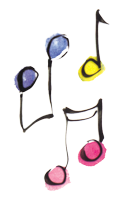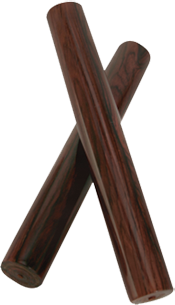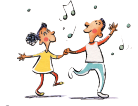Lesson 1: Learning “El manisero”
| Aim: What is the clave pattern and where can we find it in “El manisero?” Summary: Students learn to clap a basic clave pattern and sing the chorus of “El manisero.” Materials: Musical Explorers CD or online audio Time Required: 30 minutes (three 10-minute activities) Standards: GA: MK-2GM.1, MK-2GM.2, MK-2GM.6, MK-2GM.7, MK-2GM.9, MK-2GM.10 SC: MGK-2.1, MGK-2.2, MGK-2.5, MGK-2.6 Vocabulary: coro, salsa, claves, clave pattern |
Meet Gino
- Meet Gino on SG39
Sing “El manisero”
- Listen to “El manisero,”
 Track 40
Track 40
- “El manisero” is Spanish for “the peanut vendor”—“maní” means “peanuts.”
- “El manisero” is a famous song from Cuba. It is based on the cry of a street vendor selling peanuts (“Maní, maní, maní”).
- Learn and sing the first coro (Spanish for “chorus”),
 Track 41
Track 41
and Track 42
Track 42
and clap on the first and third beats.- “Que rico es el mani?” means “How delicious are peanuts?” in English.
 “Salsa” is the name given to Afro-Cuban dance music as it is played in the United States. The Spanish word salsa means “sauce” and was used in Cuba as an exclamation (“Salsa!”) when something exciting was played in music. Though the music originated in Cuba, the infusion of jazz harmony, arranging techniques, and improvisation, as well as the influence of the Puerto Rican community in America, came together to give salsa its distinct sabor (or “flavor”). “Salsa” is the name given to Afro-Cuban dance music as it is played in the United States. The Spanish word salsa means “sauce” and was used in Cuba as an exclamation (“Salsa!”) when something exciting was played in music. Though the music originated in Cuba, the infusion of jazz harmony, arranging techniques, and improvisation, as well as the influence of the Puerto Rican community in America, came together to give salsa its distinct sabor (or “flavor”).
For more history and trivia about salsa in the United States, visit Pete Nater’s Salsa Legends and Masters Academy (slamanater.com). |
- Learn and sing the second coro,
 Track 43
Track 43
and Track 44
Track 44
and clap on the first and third beats. - “Ya se va manisero, ya se va!” means “There goes the peanut vendor, there he goes!” in English.
- Listen to “El manisero” again,
 Track 40
Track 40
and sing along to each coro. Maintain the steady beat by either patting or walking on the first and third beats.
Explore the Clave Pattern
- Listen to Gino play the claves and say “bistec chuleta” in clave, and repeat along with Gino on
 Track 45
Track 45
- “Bistec chuleta” is Spanish for “steak” and “pork chops”—two of Gino’s favorite foods! They also use these words to remember how to clap the clave pattern.
- What words or combination of words can you think of that also sound like the clave pattern? (e.g., “Hello! How are you?” or “Let’s go to the park!”)
- Use SG40 to write a phrase using the clave pattern. Perform the new phrases you create with
 Track 46
Track 46 - Listen to “El manisero” again,
 Track 40
Track 40
and clap along to the clave pattern.
Creative Extension: Learn the Basic Sidestep in 2/3 Clave
|
Musical Word Wall
Add the words coro, salsa, claves, and clave pattern to the Musical Word Wall.
PDF Downloads
SG39 ↓ Download File
SG40 ↓ Download File
Video “El Manisero”
Musical Explorers Audio Tracks





